
A group of experts in Tokyo suggested pouring radioactive water from Fukushima into the open sea. A marine biochemist explains the consequences of this absurd decision.
A new study finds worrying overlap between shark hotspots and human fisheries in the high seas, leaving these animals little space in the ocean to evade the threat of being caught.
In the past, most human fishing activities were concentrated in coastal areas. However, since the 1950s, industrial fleets have expanded their effort in the high seas, raising concerns for marine species in this habitat, including sharks. Pelagic sharks living in the high seas constitute more than half of all shark species and, being top predators, play a key role in maintaining healthy marine ecosystems.
In a study recently published in the scientific journal Nature, a team of more than 150 scientists from 26 countries combined a large dataset from almost 2,000 sharks tracked across the world’s oceans. Studying the movements of these animals, the scientists identified the areas where multiple shark species aggregate, “shark hotspots”, which correspond to productive regions such as the Gulf Stream and the California Current. They then assessed the overlap of shark hotspots with the global distribution of fishing effort, focusing in particular on industrial longline fisheries. This fishing technique involves the use of lines up to 100 kilometres long, baited with hundreds of hooks, and is responsible for most of the catches of sharks, either for commercial purposes or unintentionally (by-catch).
News & Views: The expansion of industrial fishing across the high seas has created a new threat to shark as fishing grounds overlap with shark habitats. Sharks are thought to be one of the most threatened groups of marine species. https://t.co/3nTOZ1OIoH
— nature (@nature) August 7, 2019
Their findings are worrisome: important shark habitats across the globe overlap significantly with longline fisheries in time and space, with 24 per cent of the space used monthly by sharks occurring within the footprint of these activities. Species that are commercially exploited showed the highest overlap (up to 76 per cent for blue sharks), but internationally protected sharks were also found to be at risk (up to 64 per cent overlap for white sharks). Unfortunately, areas characterised by low fishing effort were also the ones that sharks used less, suggesting that limited refuge from industrial longline fishing is left for these species in the oceans.
The results of the study call for timely actions and adequate protection measures. Large marine protected areas around shark hotspots are difficult to establish and enforcement in these remote regions far from the coast is challenging, but new technologies could support innovative solutions. For example, satellite tracking of both sharks and fishing vessels could be used to develop dynamic closures of certain areas to fishing. Without prompt interventions to protect these species and their habitat, shark hotspots are at risk of disappearing in the near future.
Siamo anche su WhatsApp. Segui il canale ufficiale LifeGate per restare aggiornata, aggiornato sulle ultime notizie e sulle nostre attività.
![]()
Quest'opera è distribuita con Licenza Creative Commons Attribuzione - Non commerciale - Non opere derivate 4.0 Internazionale.
A group of experts in Tokyo suggested pouring radioactive water from Fukushima into the open sea. A marine biochemist explains the consequences of this absurd decision.
The decline in grey and humpback whales in the Pacific and Atlantic Oceans has been traced to food shortages caused by rising ocean temperatures.
The United Nations has launched a major international alliance for ocean science, undertaking a mission close to all our hearts.
The cargo ship that ran aground off the coast of Mauritius on 25 July, causing incalculable damage, has split in two and its captain has been arrested.
The largest coral reef in the world is severely threatened by climate change, but researchers are developing strategies that could contribute to saving the Great Barrier Reef.
Seychelles have extended its marine protected area, which now covers over 400,000 square kilometres, an area larger than Germany.
Norwegian oil giant Equinor had pulled out of drilling for oil in the Great Australian Bight, one of the country’s most uncontaminated areas. A victory for activists and surfers who are now campaigning for the area to be protected forever.
30 per cent of the planet needs to be protected to stop precipitous species decline. The UN has set out its aims for the the COP15 on biodiversity scheduled for Kunming, China in October.
Ocean warming has risen to record highs over the last five years: just in 2019 the heat released into the world’s oceans was equivalent to that of 5-6 atomic bombs per second. The culprit, no doubt, is climate change.








